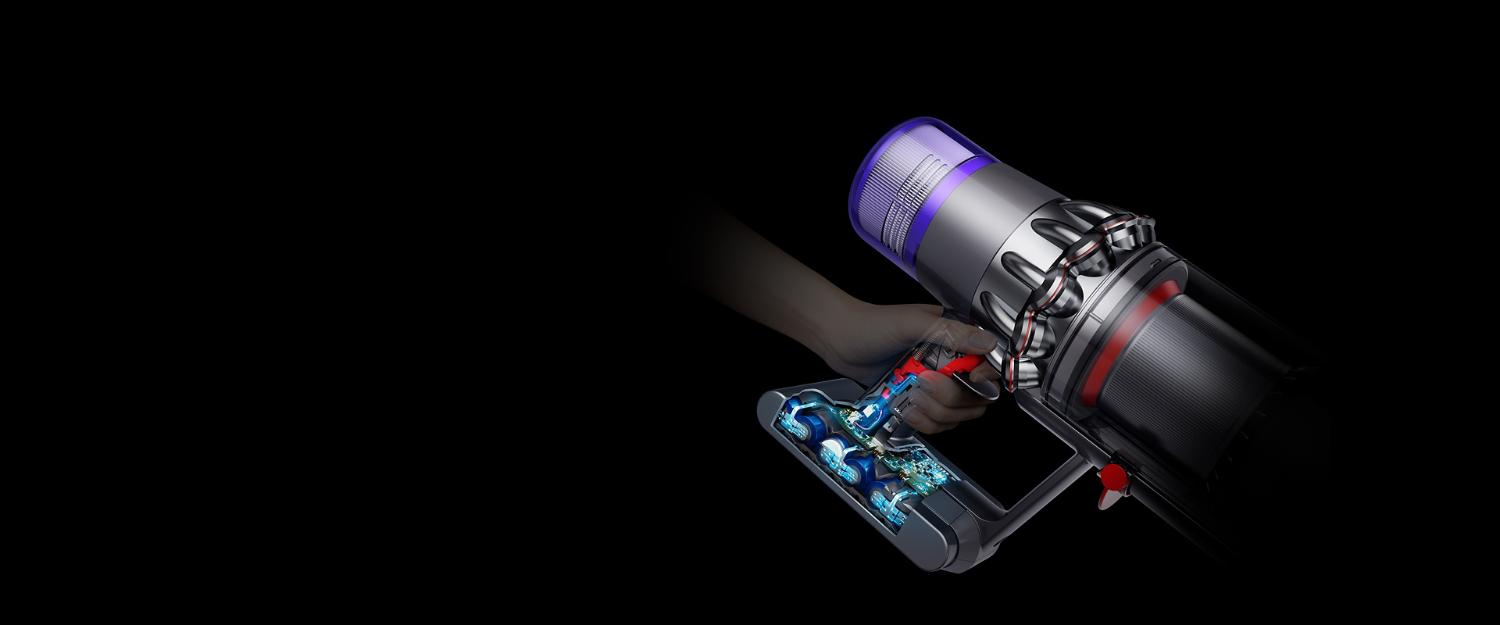-


Lean engineering: optimising energy to make more efficient machines
Dyson engineers strive to do more, with less. It's what we call 'lean engineering' and it informs everything from the materials we choose, to the energy our machines use. By marrying software and hardware together, we can use less energy and do more for the planet. Here's how we do it.
Putting time and energy into energy
Energy is an intangible thing. We can’t see it or hear it, yet it powers almost every piece of technology in our homes. And it’s something that Dyson engineers have been intrigued with for over 25 years. The fascination and desire to engineer machines that are more energy efficient, use fewer materials but still maintain performance is what has driven some of Dyson’s most iconic designs.
-

-
At the heart of these machines often sits a Dyson Hyperdymium motor, designed with energy efficiency in mind from the ground up. Over the past 20 years, Dyson has focused on the development of these tiny, high-speed, efficient motors, which take the place of the big traditional, heavier alternatives, and are four times faster and up to five times lighter. Because the in-use energy phase has always been the most impactful part of a product’s lifecycle, leaps in the efficiency of Dyson motors has made significant improvements in this respect – allowing Dyson’s engineers to maximise the performance driven from each joule of energy.
This philosophy is true across Dyson’s whole range of technology. Starting in the year 2000, the Dyson Contrarotator™– Dyson’s proprietary double-drum washing machine – was designed to use less energy and less water, washing clothes faster with a bigger load while using fewer resources. Dyson’s bladeless purifying fans are also engineered to clean the whole room, projecting more air and using less power. In the Dyson Supersonic hair dryer, the combination of the Dyson Digital motor V9 and Air Multiplier™ technology amplifies the jet of air that comes through the loop of the machine by three times, allowing hair to be dried and styled fast. For technology outside of the home, Dyson engineers invented the Dyson Airblade 9kJ hand dryer. Three years in development, the hand dryer uses up to 80 per cent less energy than other warm air hand dryers, while producing up to 85 per cent less carbon dioxide emissions per dry than paper towels*.
And Dyson holds others to the same account. Most of the energy used by a vacuum cleaner, for example, is consumed when it’s in use. So, in 2012 Dyson campaigned to put a cap on the motor wattage to force manufacturers to invest in high efficiency technology. Instead, the EU introduced a misleading energy label for vacuum cleaners which exaggerated the energy efficiency of bagged vacuum cleaners, testing them empty and with no dust, which does not reflect real-world use. This is because vacuums don’t stay empty. Bagged vacuums lose suction as they fill with dust, so performance drops. Some machines even compensate by increasing power during use. Dyson challenged this through the EU Appeal Court and eventually won, making the energy usage of vacuum cleaners more tangible for owners and helping them make more environmentally conscious decisions.
While these mechanical improvements have been instrumental in energy saving over the years, the addition of intelligent sensing not only makes Dyson machines easier to use, but also better at saving energy automatically.
Intelligently lean
The development of Auto mode on Dyson’s purifying fans, heaters and humidifiers means that the machines only use energy when they need to.
Four sensors, including a solid-state formaldehyde sensor, interact with our unique algorithm to precisely diagnose, display and react to the air quality, temperature and humidity within a home. In sensing pollution, irregular temperature or humidity levels, the machine will react. The HEPA+Carbon filter captures gases and 99.95 per cent of particles as small as 0.1 microns , while Dyson’s catalytic filter destroys formaldehyde continuously. Air Multiplier technology then projects purified heated, cooled or humidified air around the room. Once the target air quality is achieved, the machine automatically stops to preserve energy, restarting as required and not wasting energy.
Full room purification is tested with Dyson’s POLAR methodology, which uses nine sensors and no added ceiling fan in an 81m³ test chamber. This replicates a real living room, instead of small lab tests used in some industry standards, ensuring that purified air is efficiently projected to every corner of the room. This helps our engineers know that every joule of energy used by our machines is used to maximum efficiency to keep improve air quality in your home.
Automatic cleaning
Energy saving is also central to Dyson’s vacuum cleaning technology. In their latest floorcare technology, the Dynamic Load Sensing (DLS) system, unique to the High Torque cleaner head, intelligently detects brush bar resistance and automatically communicates with the motor and battery’s microprocessors to change the suction power between carpets and hard floors. This enables carpets to be deep cleaned and run time to be extended on hard floors, preserving energy when relevant.
In the Dyson V15 Detect and V12 Detect Slim, the Acoustic Dust Sensing adds an additional layer to energy saving; Dyson’s patented Piezo sensor technology.
Piezo sensors have been used on NASA space missions to detect space debris and avoid collisions with space stations. In Dyson vacuums, a Piezo sensor uses acoustics to ‘listen’ to the vibration caused by dust and debris impacting the inlet duct as it is sucked up 15,000 times a second, converting them into electrical signals. An algorithm is then used to analyse the signal to estimate the size and count – automatically increasing suction power when needed. When dust levels normalise, suction power is reduced to its previous level, preserving run-time by using less power when there’s less dirt.
*In Eco Mode
-

Tips for maximising battery life







